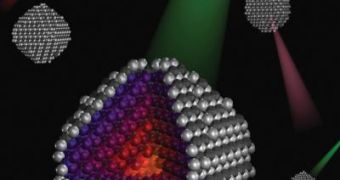Creating constantly emitting light sources from individual molecules has been something that experts have been trying to do for more than a decade, but a small inconvenience, an optical quirk known as “blinking,” has made these efforts futile. Now, researchers at the University of Rochester (UR) have managed to overcome this issue, by discovering the basic physics behind the phenomenon, e! Science News reports.
Working together with colleagues from the Eastman Kodak Company, the UR team succeeded in creating a new type of nanocrystals, which constantly emits light, overcoming “blinking.” The find could have a significant range of new applications, from constructing better laser machines to developing more luminous and more power-efficient light-emitting diodes (LEDs). New biological markers could also be created, to be used in studies of living cells. This could lead to a better understanding of the intricate processes that go on inside the human body, which have thus far eluded researchers.
Details of the find appeared yesterday (May 10th), in the early online edition of the scientific journal Nature. The scientists explain that a very large number of tiny molecules can absorb and emit light, including crystals that are in the nanoscale, meaning they have sizes a billion times smaller than a meter. But the problem with most of these molecules and crystals is that, while they constantly absorb light, they do not also radiate it in the same manner.
That is to say, rather than radiating photons away from them, they sometimes convert the sub-atomic particles into heat. This stage is known as a “dark period,” because, during it, the molecule or crystal emits no light. Dark and light periods alternate in regular light-emitting/absorbing molecules, and this is the basic mechanism behind “blinking.”
“A nanocrystal that has just absorbed the energy from a photon has two choices to rid itself of the excess energy – emission of light or of heat. If the nanocrystal emits that energy as heat, you've essentially lost that energy,” the lead author of the Nature paper, UR Professor of Chemistry Todd Krauss, explains. The new type of continuously emitting crystals is made up of a cadmium and selenium core and a shell of zinc and selenium, between which there is no clear demarcation line. This is very unusual for a nanocrystal, but it has proven to be the decisive factor in finding the correct construction. After hours of observations, the team found no evidence of blinking in the new material.
Basically, the new material absorbs a constant stream of photons, but does not convert any of them into heat. That is to say, its peculiar internal structure has the potential to avert the processes that prevent photons from being radiated back. Krauss says that the new class of materials is a lot cheaper and easier to fabricate than other types of nanocrystals, and that it offers a far better return for the money.

 14 DAY TRIAL //
14 DAY TRIAL //